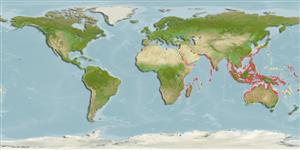Common names from other countries
Environment: milieu / climate zone / depth range / distribution range
Ecologie
; diepteverspreiding 0 - 10 m (Ref. 349). Tropical
Indo-West Pacific: from East Africa, to Melanesia; north to Japan and south to northern Queensland.
Length at first maturity / Size / Gewicht / Leeftijd
Maturity: Lm ? range ? - ? cm Max length : 14.0 cm ShH mannelijk/geslacht niet bekend; (Ref. 349); common length : 9.0 cm SHL mannelijk/geslacht niet bekend; (Ref. 349)
Length based on occurrence record; to be replaced with better reference. Common on exposed sand flats and close to dead coral areas. Shallow subtidal zones. Feed on sea urchins of the "sand dollar" group. Egg capsules forming an irregular mass which is the result of several females spawning together (Ref. 349).
Life cycle and mating behavior
Geslachtsrijpheid | Voortplanting | Kuitschieten | Eieren | Fecundity | Larven
Members of the order Neotaenioglossa are mostly gonochoric and broadcast spawners. Life cycle: Embryos develop into planktonic trocophore larvae and later into juvenile veligers before becoming fully grown adults.
Poutiers, J.M. 1998. (Ref. 349)
Status op de Rode Lijst van het IUCN (Ref. 130435)
Status bij CITES (Ref. 108899)
Not Evaluated
Not Evaluated
Gevaarlijk voor mensen
Harmless
Gebruik door de mens
Visserij: commercieel
| FishSource |
Tools
Meer informatie
Leeftijd/GrootteGroeiLengte-gewicht parametersLengte-lengte parametersMorfologieLarvenAbundantie
Internet-bronnen
Estimates based on models
Preferred temperature
(Ref.
115969): 24.7 - 29.3, mean 28.5 (based on 2842 cells).
Kwetsbaarheid
Low vulnerability (10 of 100).
Prijsklasse
Unknown.
